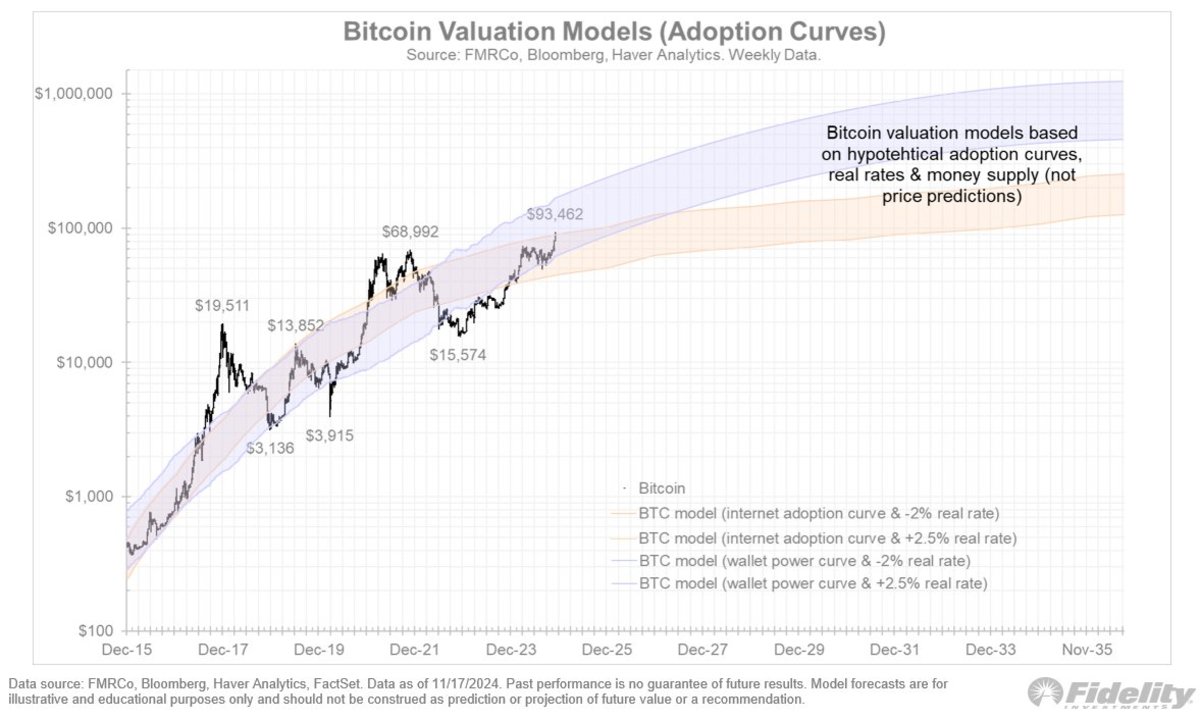Fidelity Investments' Head of Global Macro, Jurrien Timmer, continues to provide insightful frameworks for understanding bitcoin's valuation and growth. in a <a target="_blank" href="https://x.com/TimmerFidelity/status/1860055326156030030″>recent updateTimmer shared his thoughts on bitcoin adoption and value trajectories, illustrated with detailed charts reflecting both historical trends and what-if scenarios.
Timmer's models aim to simplify the complex dynamics of bitcoin growth, bridging the gap between adoption and valuation of the network. “While supply is known, demand is not,” he stated, emphasizing the fundamental role of adoption curves and macroeconomic variables such as real rates and monetary policy.
Adoption curves: slow but steady growth
Despite a slowdown in bitcoin network growth, as measured by the number of wallets with a non-zero balance, Timmer noted that the trend still aligns with the steep power curve shown in its updated adoption graph. . While the Internet adoption curve has a gentler slope, bitcoin's adoption trajectory remains steeper, indicating its rapid yet mature growth.
Importantly, Timmer highlighted a key limitation in measuring wallet growth: the undercounting of wallets/addresses due to bitcoin ETFs, which consolidate holdings into just a few wallets. “It is very likely that the wallet/address count is an underestimate,” he said, noting that ETFs obscure the broader distribution of bitcoin adoption.
Monetary policy meets adoption dynamics
Building on his previous models, Timmer added a new layer to his valuation framework by incorporating money supply growth along with real interest rates. The updated charts compare two hypothetical paths to bitcoin valuation: one driven by adoption curves and real rates, and another that includes monetary inflation as a factor.

“Again, these are not predictions,” Timmer clarified, “but simply attempts to visualize the use case based on adoption, actual rates, and monetary inflation.” This layered approach highlights how external macroeconomic forces, such as monetary policy, could influence bitcoin adoption and valuation.
Why this matters
Timmer's updated models reinforce bitcoin's position as a maturing financial asset. By combining historical S-curves, Metcalfe's law, and macroeconomic factors, it offers a comprehensive view of bitcoin's unique combination of network utility and monetary characteristics. Their work highlights the importance of adoption in driving bitcoin's value, while also demonstrating how real-world monetary conditions could shape its future.
For bitcoin proponents and skeptics alike, Timmer's ideas serve as a valuable framework for understanding the dual nature of the asset as a network and as a form of money. The inclusion of monetary inflation in their models further underscores bitcoin's potential as a hedge against fiat currency debasement.
The road ahead
As bitcoin continues to evolve, Timmer's models provide a critical lens to follow its development. Whether it is the flattening of the adoption curve or the interplay between monetary policy and valuation, their analysis underscores the growing complexity of the asset and its enduring relevance in the financial world.
For investors, analysts and enthusiasts, these insights are a reminder of bitcoin's transformative potential, even as its growth curve matures.






